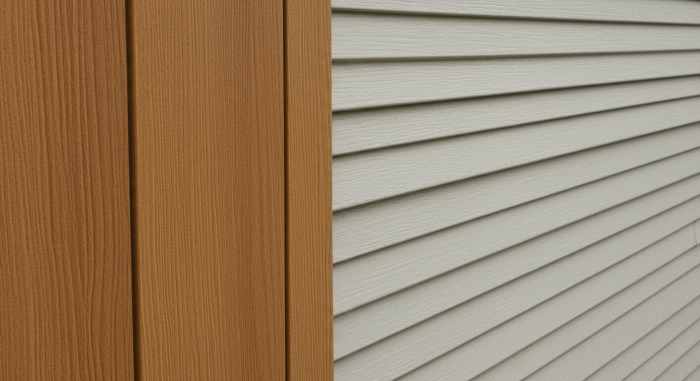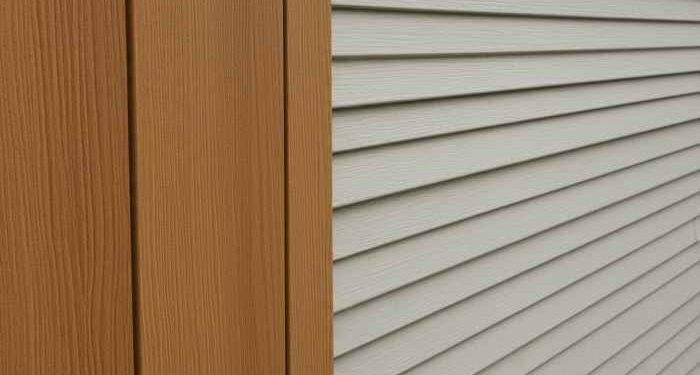Exploring the nuances between cladding and siding in architecture, this discussion delves into the fundamental definitions, materials used, and their impact on building aesthetics. Get ready to uncover the distinctive features that set these two architectural elements apart.
Cladding vs Siding

In architecture, cladding and siding are both exterior finishes that serve to protect and enhance the appearance of buildings.
Cladding refers to the application of one material over another to provide a skin or layer. It is typically non-load-bearing and can be made of a variety of materials such as wood, metal, vinyl, or composite materials.
Siding, on the other hand, is a type of cladding that specifically refers to the outer covering or cladding of a house meant to shed water and protect from the effects of weather. It can also come in various materials like wood, vinyl, fiber cement, or stucco.
Materials Used for Cladding and Siding
- Wood: Both cladding and siding can be made from natural wood, providing a traditional and rustic look.
- Metal: Metal cladding and siding offer a modern and sleek appearance, with options like aluminum, steel, or copper.
- Vinyl: Vinyl is a popular choice for both cladding and siding due to its low maintenance and versatility in color and style.
- Fiber Cement: This durable material is often used for siding as it is resistant to fire, insects, and rot.
- Stucco: Stucco is a type of plaster that can be used for both cladding and siding, providing a textured and decorative finish.
Types of Cladding
Cladding materials play a crucial role in enhancing the aesthetics and durability of a building. Let's explore various types of cladding materials along with their advantages and disadvantages.
Metal Cladding
Metal cladding, such as aluminum, steel, or copper, offers a sleek and modern look to buildings. It is durable, fire-resistant, and requires minimal maintenance. However, metal cladding can be expensive and may require specialized installation techniques.
Wood Cladding
Wood cladding provides a natural and warm appearance to buildings. It is environmentally friendly and can be easily customized. However, wood cladding is prone to rot, pests, and requires regular maintenance to prevent deterioration.
Vinyl Cladding
Vinyl cladding is cost-effective, versatile, and available in various colors and textures. It is low maintenance, resistant to moisture, and easy to install. On the downside, vinyl cladding can crack or fade over time, affecting the overall aesthetics of the building.
Brick Cladding
Brick cladding offers a classic and timeless look to buildings. It is durable, fire-resistant, and provides excellent thermal insulation. However, brick cladding can be heavy, increasing structural load, and may require professional installation for proper sealing and weatherproofing.
Examples of Buildings
- The Gherkin in London showcases a striking metal cladding facade, adding a futuristic touch to the city skyline.
- The Timber Tower in Vancouver features stunning wood cladding, blending seamlessly with the surrounding nature.
- The Vinyl Village in New York highlights the versatility of vinyl cladding in creating vibrant and modern building exteriors.
- The Brick House in Chicago demonstrates the timeless elegance of brick cladding, standing the test of time in architectural design.
Types of Siding
When it comes to siding materials, there are various options available, each with its own set of characteristics and maintenance requirements.
Wood Siding
Wood siding is a popular choice for its natural beauty and versatility. However, it requires regular maintenance such as painting or staining to protect it from rot, mold, and insects.
Fiber Cement Siding
Fiber cement siding is a durable and low-maintenance option that is resistant to fire, insects, and rot. It can mimic the look of wood, stucco, or masonry but may require occasional repainting.
Stucco Siding
Stucco siding is a traditional choice known for its durability and weather resistance
Vinyl Siding
Vinyl siding is a cost-effective option that is easy to maintain and comes in a variety of colors and styles. It is resistant to rot, insects, and fading, making it a popular choice for many homeowners.
Brick Siding
Brick siding is a timeless choice that is durable, fire-resistant, and low-maintenance. While it may be more expensive upfront, it can last for decades with minimal upkeep.
Metal Siding
Metal siding, such as aluminum or steel, is a durable and low-maintenance option that is resistant to fire, insects, and rot. It can be more expensive than other materials but offers long-term durability and energy efficiency.
Cost-Effectiveness Comparison
When comparing the cost-effectiveness of various siding materials, it is essential to consider not only the initial cost but also the long-term maintenance requirements and durability. While some materials may be more expensive upfront, they could save money in the long run by requiring less maintenance and lasting longer.
Design and Aesthetics
When it comes to the design and aesthetics of a building, both cladding and siding play a crucial role in enhancing the overall look and feel. These exterior finishes not only provide protection but also contribute to the architectural style and visual appeal of a structure.Cladding and siding offer a wide range of options in terms of colors, textures, and patterns, allowing architects and designers to create unique and visually striking facades.
The choice of material, whether it be wood, metal, vinyl, or fiber cement, can greatly impact the aesthetic of a building.
Impact of Colors, Textures, and Patterns
- The use of bold colors can make a building stand out and create a striking visual impact. For example, a building with red or yellow cladding can catch the eye and become a focal point in its surroundings.
- Textures such as smooth, rough, or patterned surfaces can add depth and visual interest to a building facade. A combination of different textures can create a dynamic and engaging look.
- Patterns like horizontal or vertical lines, geometric shapes, or even custom designs can help to define the architectural style of a building. For instance, a modern building may feature sleek, clean lines in its cladding design.
Examples of Standout Cladding and Siding Design
- The Guggenheim Museum in Bilbao, Spain, is a prime example of how cladding design can transform a building into a work of art. The titanium panels used in its construction create a futuristic and dynamic exterior.
- The Fallingwater house in Pennsylvania, designed by Frank Lloyd Wright, showcases how natural materials like stone and wood siding can blend seamlessly with the surrounding environment, enhancing the organic aesthetic of the architecture.
- The Burj Khalifa in Dubai features a unique glass cladding system that reflects the sky and creates a shimmering effect, adding a touch of luxury and sophistication to the tallest building in the world.
Durability and Weather Resistance
When it comes to durability and weather resistance, the choice between cladding and siding materials plays a crucial role in determining the longevity and maintenance of a building. Let's delve into how these materials stack up against each other in terms of weather resistance and durability.
Durability Comparison
- Cladding materials such as brick, stone, and metal are known for their exceptional durability and can last for decades without significant wear and tear.
- Siding materials like vinyl and wood are also durable but may require more maintenance over time to prevent damage from moisture and other environmental factors.
Weather Resistance
- Cladding materials are often more resistant to harsh weather conditions such as extreme heat, cold, and moisture, making them ideal for buildings in challenging climates.
- Siding materials can be susceptible to warping, fading, and rotting when exposed to prolonged sunlight, rain, or snow, requiring regular upkeep to maintain their integrity.
Longevity of Buildings
- Buildings with durable cladding materials tend to have a longer lifespan and require less frequent repairs or replacements compared to those with siding materials.
- The choice of cladding or siding can significantly impact the overall longevity and maintenance costs of a building, making it essential to select the right material based on the specific environmental conditions and aesthetic preferences.
Closing Summary
As we conclude our exploration of cladding vs siding in architecture, it's evident that these elements play a crucial role in not just protecting buildings but also enhancing their visual appeal. The diverse range of materials and design possibilities offer a fascinating array of choices for architects and designers alike.
FAQ Overview
What are the maintenance requirements for cladding and siding materials?
Cladding materials like metal may require periodic cleaning and maintenance, while siding materials such as wood may need regular painting or sealing to prevent rot.
How do cladding and siding materials differ in terms of weather resistance?
Cladding materials like metal are known for their durability in harsh weather conditions, whereas siding materials like fiber cement offer excellent resistance to moisture and pests.
Can cladding and siding impact the energy efficiency of a building?
Absolutely, both cladding and siding choices can influence the insulation properties of a building, thereby affecting its overall energy efficiency.




